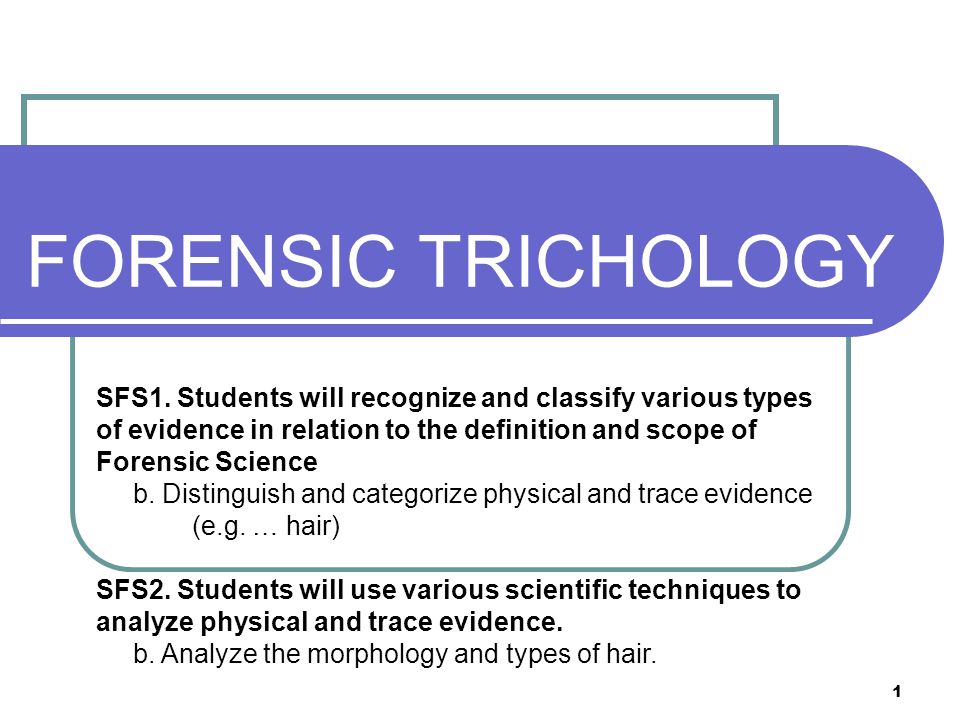
Introduction
Forensic trichology is the forensic scientific examination of human hair, including analysis of hair recovered from crime scenes. or on victims to determine aspects such as species origin, racial origin, body location, and whether it has been forcibly removed. It can be valuable evidence in cases involving violent crimes, as hair provides evidences about the perpetrator or the circumstances surrounding the crime. Trichologists use various techniques, including microscopic examination and chemical analysis, to extract relevant information from hair samples.
Structure of Human Hair-
Human hair constitutes mainly of keratin protein, which is also found in the skin and nails. Hair has a complex structure that includes several layers:
Cuticle: The outermost layer of hair, made up of overlapping scales that point towards the tip of the hair. The cuticle protects the inner layers of the hair.
Cortex: The middle layer, which gives hair its strength, elasticity, and color. The cortex contains melanin, which determines the color of the hair.
Medulla: The innermost layer, which is a soft, spongy substance. Not all hairs have a medulla, and its presence, size, and structure can vary among individuals and even among hairs on the same person.
Types of Human Hair
In forensic science, various types of hair may be encountered and examined for different purposes. These types include:
• Head Hair: Head hair is the most common type of hair encountered in forensic investigations. It can vary in texture, color, and length, and is often used for DNA analysis and individual identification.
• Pubic Hair: Pubic hair grows in the pubic region and can also vary in texture, color, and length. Pubic hair is often encountered in cases of sexual assault and can provide valuable evidence for linking suspects to crime scenes.
• Facial Hair: Facial hair includes hair found on the face, such as beard hair and mustache hair. Like head and pubic hair, facial hair can be analyzed for DNA and other forensic purposes.
• Body Hair: Body hair includes hair located on various body parts like the arms, legs, chest, and back. Although less frequently encountered than head or pubic hair, body hair can also be examined for forensic purposes
• Animal Hair: In some cases, animal hair could be encountered at crime scenes. Animal hair can be distinguished from human hair’s based on its structure and morphology and can provide valuable information about the presence of animals at a crime scene.
Types of Hair Pattern
In forensic science and anthropology, hair patterns denote the innate growth patterns and arrangement of hair across the human body. These patterns can vary widely among individuals and can provide valuable information for identifying individuals and determining characteristics such as age, sex, and ethnicity. Some common types of hair patterns include:
• Whorls: Whorls are circular or spiral patterns of hair growth. They are commonly found on the crown of the head and can be clockwise or counterclockwise. Whorls are often used in forensic science for individual identification, as they are unique to each person.
• Cowlicks: Cowlicks are small, localized areas of hair that grow in a different direction from the surrounding hair. They are most commonly found on the crown of the head and are often associated with whorls.
•Straight, Wavy, and Curly Hair: The texture of hair can vary widely among individuals, from straight to wavy to curly. This variation is determined by the shape of the hair follicle and is often used to determine ethnicity and ancestry.
•Pattern Baldness: Pattern baldness refers to the specific patterns of hair loss that occur in certain individuals, such as male and female pattern baldness. These patterns can be inherited and can provide valuable information for identifying individuals and determining familial relationships.
•Beard and Body Hair Patterns: The distribution of hair on the face and body can also vary among individuals. Beard patterns, for example, can vary in density and distribution, while body hair patterns can vary in thickness and coverage.
Human and Animal Hair-
Human and animal hair differ in several ways, including their structure, growth patterns, and functions. These differences are important in forensic science for distinguishing between human and animal hair and for identifying the species of animal from which the hair originated. Here are some key differences between human and animal hair:
• Structure: Human hair tends to be finer and more consistently sized than animal hair, which can vary in thickness and texture. Additionally, human hair has a complex composition, including the cuticle, cortex, and medulla, whereas animal hair may have a simpler structure with different scale patterns.
• Medulla: The medulla, or innermost layer of the hair shaft, is often more prominent in animal hair than in human hair. In some animal species, such as cats, the medulla may be continuous and wide, while in others, such as dogs, it may be intermittent or absent.
• Cuticle Scale Patterns: The scale patterns found on human hair’s cuticle are typically more consistent and orderly than those on animal hair. Animal hair, on the other hand, might exhibit scale patterns that are less uniform or symmetrical, enabling the differentiation of various animal species.
• Pigmentation: Human hair tends to have a more consistent and uniform color compared to animal hair, which can show variations in color and pattern along its length..
• Growth Patterns: The growth patterns of human and animal hair can vary. For example, the distribution of hair on the body, the length of the growth cycle, and the rate of growth can differ between humans and animals.
• Function: Human hair serves primarily as a thermal insulator and sensory organ, while animal hair can serve a variety of functions, including camouflage, protection from the elements, and communication.
Importance of Hair in Forensic Science
Hair plays a significant role in forensic science, offering valuable insights and evidence in criminal investigations. Its importance stems from its ability to provide information about individuals, crime scenes, and events. Here are some key aspects highlighting the importance of hair in forensic science:
Individual Identification: One of the primary uses of hair in forensic science is individual identification. Hair contains DNA within its follicle cells, which can be extracted and analyzed to create a DNA profile unique to each individual. This DNA profile can be compared to known individuals, such as suspects or missing persons, to establish or exclude their involvement in a crime.
Linking Suspects to Crime Scenes: -
Hair found at a crime scene can provide crucial evidence for linking suspects to the location. If a hair matches the DNA profile of a suspect, it can serve as strong evidence of their presence at the scene, especially if other forms of evidence are lacking.
Time Since Activity:
Hair growth patterns can provide information about the time since certain activities occurred. By analyzing the length and condition of hair, forensic experts can estimate the time since it was last cut or pulled from the root, providing insights into events such as a struggle or the deposition of a body.
Evidence of Trauma:
Hair can provide evidence of trauma or violence. Broken or damaged hair shafts, as well as hair pulled from the root, can indicate a struggle or forcible removal. Analysis of such hair can help reconstruct events leading to injury or death.
Conclusion:
Hair can provide evidence of trauma or violence. Broken or damaged hair shafts, as well as hair pulled from the root, can indicate a struggle or forcible removal. Analysis of such hair can help reconstruct events leading to injury or death.
Drug and Toxin Exposure:
Hair can retain evidence of drug use or exposure to toxins. Chemical analysis of hair can reveal a person’s history of drug use or exposure to environmental contaminants, providing valuable information for criminal investigations.
Determining Origin and Body Location:
Forensic trichology, the study of hair, can help determine the origin and body location of hair samples found at crime scenes. By examining the structure and pigment of the hair, experts can determine whether it is of human origin, its racial origin, and even the body location from which it was removed.
Sexual Assault Investigations:
In cases of sexual assault, hair evidence can provide crucial information for identifying perpetrators and corroborating victim statements. Hair found on the victim or at the crime scene can link suspects to the crime and provide valuable evidence for prosecution.
Collection of Hair Evidence
Collecting hair evidence properly is crucial to maintaining its integrity and ensuring it can be used effectively in forensic analysis. Here are the key steps involved in the collection of hair evidence:
Documentation: Before collecting any evidence, thoroughly document the location, date, and time of the collection, as well as any relevant observations about the scene.
Personal Protective Equipment (PPE): Wear appropriate PPE, such as gloves and a mask, to prevent contamination of the evidence and protect yourself.
Locating and Marking: Locate any hair evidence at the crime scene and mark its location without touching or disturbing it.
Collection Tools: Use clean and sterile tools, such as forceps or tweezers, to collect individual hairs. Avoid using your fingers, as this can transfer oils and DNA.
Collection Method: For loose hairs, gently pick them up using the collection tool and place them in a clean paper envelope or plastic bag. For hairs that are still attached to the body or an object, carefully cut or pluck them, ensuring the root or follicle is intact.
Avoiding Cross-Contamination: Use a new collection tool for each hair sample to avoid cross-contamination. Store each sample separately to prevent mixing.
Packaging: Place the collected hair samples in a clean, dry, and breathable container, such as a paper envelope or a breathable evidence bag. Avoid using plastic bags, as they can trap moisture and promote mold growth.
Labeling: Label each sample with a unique identifier, such as the case number, date, and location of collection, as well as any other relevant information.
Examination of Hair Sample-
Analytical Techniques for Hair Examination
Microscopic Examination: Microscopic analysis of hair involves studying the hair’s structure, including the cuticle, cortex, and medulla. This examination can reveal characteristics such as hair type, race, and whether the hair has been forcibly removed.
Chemical Analysis: Chemical analysis of hair can provide information about drug use, toxins, or other substances present in the body. Techniques such as mass spectrometry can detect trace amounts of substances in hair samples.
DNA Analysis: Analyzing DNA from hair follicle cells can reveal an individual’s genetic profile, which proves valuable in identifying suspects or victims in cases where other evidence is insufficient.
Comparative Analysis: Comparative analysis entails contrasting hair samples from various origins to ascertain whether they correspond. This method can aid in connecting suspects to crime scenes or victims.

Ms. Ananya G
Assistant Professor Geeta University
Related Posts
Capital asset valuation model: Possible solutions to some deficiencies
INTRODUCTION Capital Asset Valuation Models (CAVMs) play a critical role in modern finance by providing frameworks to estimate the expected returns and risks associated with

The Importance of Internships for Career Readiness – Geeta University
The Importance of Internships for Career Readiness – Geeta University In today’s competitive job market, academic qualifications alone may not be sufficient to secure a
